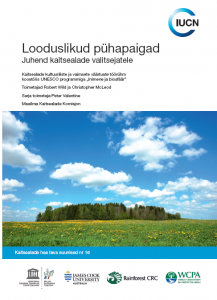
ಎಸ್ಟೋನಿಯಾ, ಸುಮಾರು 2500 ಸಾಂಪ್ರದಾಯಿಕ ಪವಿತ್ರವಾದ ಸ್ವಾಭಾವಿಕ ಸೈಟ್ಗಳು, ದೊಡ್ಡ ಪ್ರಮಾಣದ ಜಮೀನನ್ನು ಒಳಗೊಂಡ ಗಣನೀಯ ಆಧ್ಯಾತ್ಮಿಕ ಹೊಂದಿರುವಂತೆ ಕರೆಯಲಾಗುತ್ತದೆ, ಸಾಂಸ್ಕೃತಿಕ ಮತ್ತು ನೈಸರ್ಗಿಕ ಪರಂಪರೆ ಮೌಲ್ಯಗಳು. ಹೆಚ್ಚಿನ ಸಂಶೋಧನೆ ಮತ್ತು ದಸ್ತಾವೇಜನ್ನು ಎಷ್ಟು ಮಾಹಿತಿ ಜಾಲವನ್ನು ಬಹಿರಂಗಪಡಿಸಲು ನಿರೀಕ್ಷಿಸಲಾಗಿದೆ 7000 ಏಕಾಂಗಿಯಾಗಿ ದೇಶದಲ್ಲಿ ಪವಿತ್ರವಾದ ಸ್ವಾಭಾವಿಕ ಸೈಟ್ಗಳು.
 ಎಸ್ಟೋನಿಯನ್ ಪರಿಸರ ಸಚಿವಾಲಯದ ಬೆಂಬಲದೊಂದಿಗೆ NGO “ಎಸ್ಟೋನಿಯನ್ ಹೌಸ್ ಆಫ್ ತಾರಾ ಮತ್ತು ಸ್ಥಳೀಯ ಧರ್ಮಗಳು (ಕ್ರೈಸ್ತೇತರರು ಮತ್ತು ಮೌಸುಲಿಗಳ ಮಾವಲ್ಲ ಚೇಂಬರ್)” IUCN UNESCO ಅನ್ನು ಅನುವಾದಿಸಿದ್ದಾರೆ “ಪವಿತ್ರವಾದ ಸ್ವಾಭಾವಿಕ ಸೈಟ್ಗಳು, ರಕ್ಷಿತ ಕ್ಷೇತ್ರ ವ್ಯವಸ್ಥಾಪಕರು ಮಾರ್ಗಸೂಚಿಗಳು” ಎಸ್ಟೋನಿಯನ್ ಭಾಷೆಗೆ. ರಾಜ್ಯ ಪರಿಸರ ಸಂಸ್ಥೆಗಳ ಸಹಕಾರದೊಂದಿಗೆ ಮಾವಲ್ಲ ಕೊಡವು ಈಗ ಗುರುತಿಸುವಿಕೆಯನ್ನು ಸುಧಾರಿಸಲು ಮಾರ್ಗಸೂಚಿಗಳನ್ನು ಬಳಸಲು ಸಮರ್ಥವಾಗಿದೆ, ಪವಿತ್ರ ನೈಸರ್ಗಿಕ ತಾಣಗಳ ರಕ್ಷಣೆ ಮತ್ತು ಪ್ರಚಾರ. ಮಾರ್ಗಸೂಚಿಗಳು ಪವಿತ್ರ ನೈಸರ್ಗಿಕ ತಾಣಗಳಿಗಾಗಿ ಸಂಸ್ಕೃತಿ ಸಚಿವಾಲಯದ ರಾಷ್ಟ್ರೀಯ ಸಂರಕ್ಷಣಾ ಯೋಜನೆಯ ಅನುಷ್ಠಾನಕ್ಕೆ ಕೊಡುಗೆ ನೀಡುತ್ತವೆ ಮತ್ತು ರಾಜ್ಯ ಅಧಿಕಾರಿಗಳು ಮತ್ತು ಪವಿತ್ರ ನೈಸರ್ಗಿಕ ತಾಣಗಳ ಪಾಲಕರಿಗೆ ತರಬೇತಿ ನೀಡುವ ಮೂಲಕ ಬೆಂಬಲಿಸಲಾಗುತ್ತದೆ.. ಈ ನಿಟ್ಟಿನಲ್ಲಿ ಬೆಂಬಲ ಗುಂಪನ್ನು ರಚಿಸಲಾಗಿದೆ 17 ವಸಂತಕಾಲದಲ್ಲಿ ಎಸ್ಟೋನಿಯನ್ ಸಂಸತ್ತಿನ ಸದಸ್ಯರು 2011.
ಎಸ್ಟೋನಿಯನ್ ಪರಿಸರ ಸಚಿವಾಲಯದ ಬೆಂಬಲದೊಂದಿಗೆ NGO “ಎಸ್ಟೋನಿಯನ್ ಹೌಸ್ ಆಫ್ ತಾರಾ ಮತ್ತು ಸ್ಥಳೀಯ ಧರ್ಮಗಳು (ಕ್ರೈಸ್ತೇತರರು ಮತ್ತು ಮೌಸುಲಿಗಳ ಮಾವಲ್ಲ ಚೇಂಬರ್)” IUCN UNESCO ಅನ್ನು ಅನುವಾದಿಸಿದ್ದಾರೆ “ಪವಿತ್ರವಾದ ಸ್ವಾಭಾವಿಕ ಸೈಟ್ಗಳು, ರಕ್ಷಿತ ಕ್ಷೇತ್ರ ವ್ಯವಸ್ಥಾಪಕರು ಮಾರ್ಗಸೂಚಿಗಳು” ಎಸ್ಟೋನಿಯನ್ ಭಾಷೆಗೆ. ರಾಜ್ಯ ಪರಿಸರ ಸಂಸ್ಥೆಗಳ ಸಹಕಾರದೊಂದಿಗೆ ಮಾವಲ್ಲ ಕೊಡವು ಈಗ ಗುರುತಿಸುವಿಕೆಯನ್ನು ಸುಧಾರಿಸಲು ಮಾರ್ಗಸೂಚಿಗಳನ್ನು ಬಳಸಲು ಸಮರ್ಥವಾಗಿದೆ, ಪವಿತ್ರ ನೈಸರ್ಗಿಕ ತಾಣಗಳ ರಕ್ಷಣೆ ಮತ್ತು ಪ್ರಚಾರ. ಮಾರ್ಗಸೂಚಿಗಳು ಪವಿತ್ರ ನೈಸರ್ಗಿಕ ತಾಣಗಳಿಗಾಗಿ ಸಂಸ್ಕೃತಿ ಸಚಿವಾಲಯದ ರಾಷ್ಟ್ರೀಯ ಸಂರಕ್ಷಣಾ ಯೋಜನೆಯ ಅನುಷ್ಠಾನಕ್ಕೆ ಕೊಡುಗೆ ನೀಡುತ್ತವೆ ಮತ್ತು ರಾಜ್ಯ ಅಧಿಕಾರಿಗಳು ಮತ್ತು ಪವಿತ್ರ ನೈಸರ್ಗಿಕ ತಾಣಗಳ ಪಾಲಕರಿಗೆ ತರಬೇತಿ ನೀಡುವ ಮೂಲಕ ಬೆಂಬಲಿಸಲಾಗುತ್ತದೆ.. ಈ ನಿಟ್ಟಿನಲ್ಲಿ ಬೆಂಬಲ ಗುಂಪನ್ನು ರಚಿಸಲಾಗಿದೆ 17 ವಸಂತಕಾಲದಲ್ಲಿ ಎಸ್ಟೋನಿಯನ್ ಸಂಸತ್ತಿನ ಸದಸ್ಯರು 2011.
ಮಾರ್ಗಸೂಚಿಗಳು ಸಂಖ್ಯೆಗಳಾಗಿವೆ 16 ಸಂರಕ್ಷಿತ ಪ್ರದೇಶಗಳ ವಿಶ್ವ ಆಯೋಗದಲ್ಲಿ’ ಅತ್ಯುತ್ತಮ ಅಭ್ಯಾಸ ಸರಣಿ (ಇಲ್ಲಿ ವೀಕ್ಷಿಸಿ) ಮತ್ತು ಸಂರಕ್ಷಿತ ಪ್ರದೇಶಗಳ ಸಾಂಸ್ಕೃತಿಕ ಮತ್ತು ಆಧ್ಯಾತ್ಮಿಕ ಮೌಲ್ಯಗಳ ತಜ್ಞರ ಗುಂಪಿನಿಂದ ಅಭಿವೃದ್ಧಿಪಡಿಸಲಾಗಿದೆ. "ಮಾರ್ಗಸೂಚಿಗಳು ಹೆಚ್ಚಿನ ಬೇಡಿಕೆಯಲ್ಲಿವೆ. IUCN ವರ್ಲ್ಡ್ ಕನ್ಸರ್ವೇಶನ್ ಕಾಂಗ್ರೆಸ್ನಲ್ಲಿ ಪ್ರಾರಂಭವಾದಾಗಿನಿಂದ 2008 ಅವುಗಳನ್ನು ಇಂಗ್ಲಿಷ್ನಿಂದ ರಷ್ಯನ್ ಭಾಷೆಗೆ ಅನುವಾದಿಸಲಾಗಿದೆ, ಸ್ಪ್ಯಾನಿಷ್ ಮತ್ತು ಎಸ್ಟೋನಿಯನ್ ಮತ್ತು ಫ್ರೆಂಚ್ ಮತ್ತು ಜಪಾನೀಸ್ ಆವೃತ್ತಿಗಳು ತಯಾರಿಕೆಯಲ್ಲಿವೆ" ಎಂದು ಶ್ರೀ ಹೇಳುತ್ತಾರೆ. ರಾಬರ್ಟ್ ವೈಲ್ಡ್, ಮಾರ್ಗಸೂಚಿಗಳ ಸಹ-ಲೇಖಕರು ಮತ್ತು CSVPA ಗೆ ಅಧ್ಯಕ್ಷರು. WCPA ಮತ್ತು ಕ್ರಿಸ್ಟೇನ್ಸೆನ್ ಫಂಡ್ನ ಬೆಂಬಲದೊಂದಿಗೆ ಪ್ರಸ್ತುತ ಮಾರ್ಗಸೂಚಿಗಳನ್ನು ಅನುವಾದಿಸಲಾಗುತ್ತಿದೆ, ಪರೀಕ್ಷಿಸಲಾಯಿತು, ಸೇಕ್ರೆಡ್ ನ್ಯಾಚುರಲ್ ಸೈಟ್ಸ್ ಇನಿಶಿಯೇಟಿವ್ನಿಂದ ಹೊಸ ಕೇಸ್ ಸ್ಟಡೀಸ್ನೊಂದಿಗೆ ಪರಿಶೀಲಿಸಲಾಗಿದೆ ಮತ್ತು ವಿಸ್ತರಿಸಲಾಗಿದೆ.
ಪವಿತ್ರ ನೈಸರ್ಗಿಕ ತಾಣಗಳ ಸಂರಕ್ಷಣೆಯ ಎಸ್ಟೋನಿಯನ್ ಪ್ರಕರಣವು ಸರಿಸುಮಾರು ಒಂದಾಗಿದೆ 35 ಭಾಗವಾಗಿರುವ ಪ್ರಕರಣಗಳು ಡೆಲಾಸ್ ಇನಿಶಿಯೇಟಿವ್, ತಾಂತ್ರಿಕವಾಗಿ ಅಭಿವೃದ್ಧಿ ಹೊಂದಿದ ದೇಶಗಳಲ್ಲಿ ಹೆದರಿಕೆಯ ನೈಸರ್ಗಿಕ ತಾಣಗಳ ಸಂರಕ್ಷಣೆಯನ್ನು ಸುಧಾರಿಸಲು ಕೆಲಸ ಮಾಡುವ ಉಪಕ್ರಮ. “ಇನಾರಿಯಲ್ಲಿನ ಡೆಲೋಸ್ ಇನಿಶಿಯೇಟಿವ್ನ ಮೂರನೇ ಕಾರ್ಯಾಗಾರದ ಸಮಯದಲ್ಲಿ 2010 ವಿಶ್ವಾದ್ಯಂತ ಪವಿತ್ರ ನೈಸರ್ಗಿಕ ತಾಣಗಳನ್ನು ಸಂರಕ್ಷಿಸಲು ಮತ್ತು ಸಂರಕ್ಷಿಸಲು ಸಾಂಸ್ಕೃತಿಕ ಮತ್ತು ಆಧ್ಯಾತ್ಮಿಕ ಮೌಲ್ಯಗಳ ಕುರಿತು IUCN ನ ಸ್ಪೆಷಲಿಸ್ಟ್ ಗ್ರೂಪ್ ಪ್ರಯತ್ನಗಳ ಬಗ್ಗೆ ನಾನು ಕಲಿತಿದ್ದೇನೆ. IUCN UNESCO ಮಾರ್ಗಸೂಚಿಗಳು ಎಸ್ಟೋನಿಯಾದಲ್ಲಿನ ಪವಿತ್ರ ನೈಸರ್ಗಿಕ ತಾಣಗಳನ್ನು ಸಂರಕ್ಷಿಸಲು ಅತ್ಯಂತ ಪರಿಣಾಮಕಾರಿ ಸಾಧನವಾಗಿದೆ ಎಂದು ನಾನು ಅರಿತುಕೊಂಡೆ” ಶ್ರೀ ಹೇಳುತ್ತಾರೆ. ಮಾವಲ್ಲ ಕೊಡದ ಹಿರಿಯ ಅಥೋ ಕಾಸಿಕ್.
ಎಸ್ಟೋನಿಯಾದ ಒಟ್ಟು ವಿಸ್ತೀರ್ಣವು ಹೆಚ್ಚಿಲ್ಲವಾದರೂ 47.000 KM2, ಹಲವಾರು ವಿಭಿನ್ನ ಭಾಷಾ ಮತ್ತು ಸಾಂಸ್ಕೃತಿಕ ಪ್ರದೇಶಗಳು ಅದರ ಭೂಪ್ರದೇಶದಲ್ಲಿ ಕಂಡುಬರುತ್ತವೆ, ಮತ್ತು ಆದ್ದರಿಂದ ಪವಿತ್ರ ನೈಸರ್ಗಿಕ ತಾಣಗಳ ಪ್ರಕಾರಗಳು ಮತ್ತು ಹೆಸರುಗಳಲ್ಲಿ ಪ್ರಾದೇಶಿಕ ವ್ಯತ್ಯಾಸಗಳಿವೆ. ಉದಾಹರಣೆಗೆ, ದೇಶದ ಪಶ್ಚಿಮ ಭಾಗದಲ್ಲಿ ಚಿಕಿತ್ಸೆಗಾಗಿ ಬಳಸುವ ಕಲ್ಲುಗಳು ಮತ್ತು ಮರಗಳು ಸಾಮಾನ್ಯವಾಗಿದೆ. ಎಂಬ ಹೆಸರನ್ನು ಹೊಂದಿರುವ ಸಾಮುದಾಯಿಕ ತಾಣಗಳು ಇವುಗಳಿಗೆ (ಪವಿತ್ರ ತೋಪು) ದೇಶದ ಉತ್ತರ ಮತ್ತು ಪಶ್ಚಿಮ ಭಾಗಗಳಲ್ಲಿ ಹರಡಿವೆ. ಅಂತ್ಯಕ್ರಿಯೆಯ ಪದ್ಧತಿಗಳಿಗೆ ಸಂಬಂಧಿಸಿದ ಅಡ್ಡ-ಮರಗಳ ಸಂಪ್ರದಾಯವನ್ನು ಆಗ್ನೇಯ ಎಸ್ಟೋನಿಯಾದಲ್ಲಿ ಮಾತ್ರ ಸಂರಕ್ಷಿಸಲಾಗಿದೆ..
ವಿಶಾಲ ದೃಷ್ಟಿಕೋನದಿಂದ, ಎಸ್ಟೋನಿಯನ್ ಪವಿತ್ರ ನೈಸರ್ಗಿಕ ತಾಣಗಳು ಫೆನ್ನೊ-ಉಗ್ರಿಕ್ ಪವಿತ್ರ ಸೈಟ್ ಸಂಪ್ರದಾಯಗಳ ಭಾಗವಾಗಿದೆ. ಐತಿಹಾಸಿಕ ಕಾರಣಗಳಿಗಾಗಿ, ಎಸ್ಟೋನಿಯನ್ ಸಾಂಪ್ರದಾಯಿಕ ಧರ್ಮ ಆಸ್ಕ್ ಹೆಚ್ಚಾಗಿ ಕೌಟುಂಬಿಕವಾಗಿ ವಿಕಸನಗೊಂಡಿದೆ, ವೈಯಕ್ತಿಕ ಮತ್ತು ಗೌಪ್ಯ. ಪವಿತ್ರವಾದ ನೈಸರ್ಗಿಕ ತಾಣಗಳನ್ನು ಪ್ರಾರ್ಥನೆಗಾಗಿ ಬಳಸಲಾಗುತ್ತದೆ, ಗುಣಪಡಿಸುವುದು, ಒಬ್ಬರ ಮದುವೆಗೆ ಆಶೀರ್ವಾದವನ್ನು ಕೇಳುವುದು, ಒಬ್ಬರ ಮಗುವಿಗೆ ಹೆಸರನ್ನು ನೀಡುವುದು, ಸಮಾಲೋಚನೆ, ಕಾಣಿಕೆಗಳನ್ನು ಸಲ್ಲಿಸುವುದು ಮತ್ತು ವಿವಿಧ ಆಚರಣೆಗಳನ್ನು ನಡೆಸುವುದು, ವಿಶೇಷವಾಗಿ ಜಾನಪದ ಕ್ಯಾಲೆಂಡರ್ನ ಪವಿತ್ರ ದಿನಗಳಲ್ಲಿ. ಇಂದು, ಪವಿತ್ರ ನೈಸರ್ಗಿಕ ತಾಣಗಳು ಮುಖ್ಯವಾಗಿ ಕಾನೂನು ನಿಯಂತ್ರಣ ಮತ್ತು ಪವಿತ್ರ ನೈಸರ್ಗಿಕ ತಾಣಗಳ ಬಗ್ಗೆ ಅರಿವಿನ ಕೊರತೆಯಿಂದಾಗಿ ಅಳಿವಿನ ಅಪಾಯದಲ್ಲಿದೆ.






